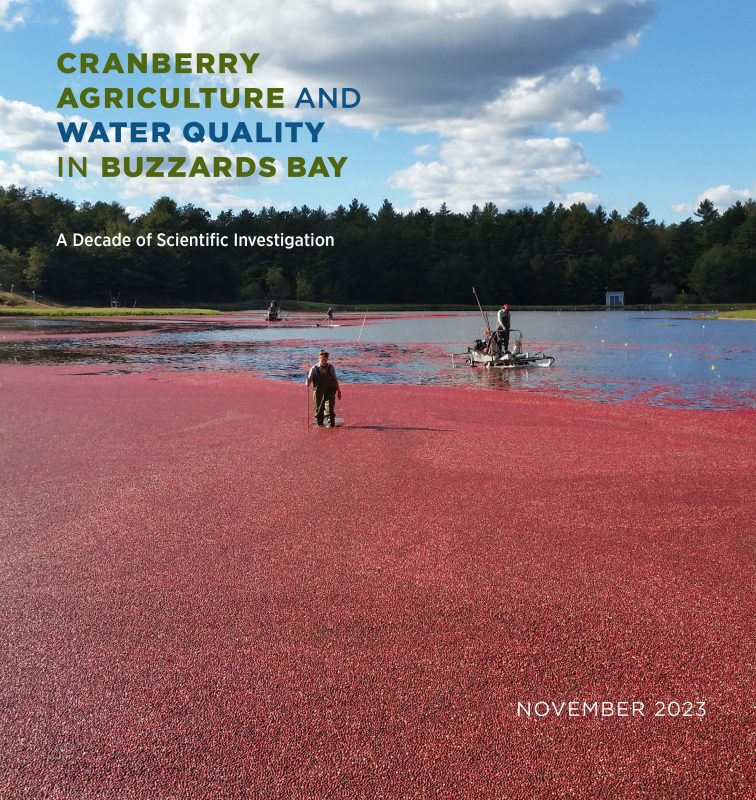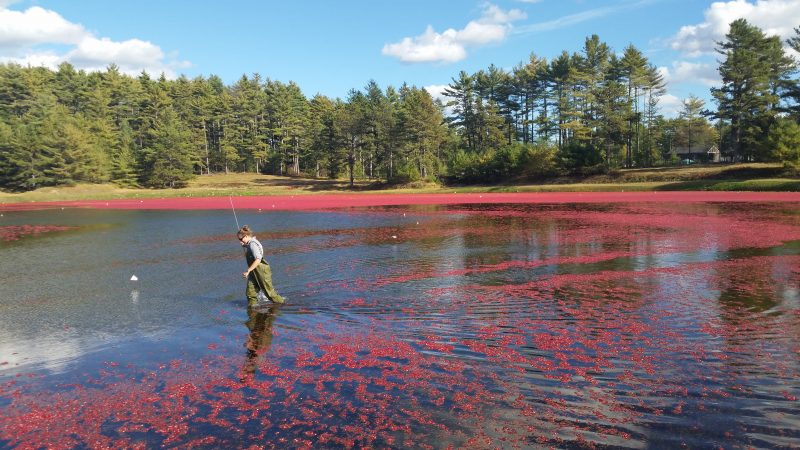BBC and Partners Release 10 Years of Water Quality Research on Cranberry Bogs
Over a decade in the making, a new report entitled “Cranberry Agriculture and Water Quality in Buzzards Bay” addresses the role that cranberry bogs play in the management of nitrogen and phosphorous in our region. The conclusions reached will help to develop management practices and restoration strategies that will improve water quality in the Bay.
The report was created in partnership with the Woodwell Climate Research Center, the USDA Agricultural Research Service, UMass Cranberry Station, the Cape Cod Cranberry Growers Association, the Southeastern Regional Planning & Economic Development District, and the Marine Biological Laboratory in Woods Hole.

“The cranberry bogs that turn our area red in fall are one of the things that make Southeastern Massachusetts unique,” explains Dr. Rachel Jakuba, Buzzards Bay Coalition’s Vice President for Bay Science. ”As features that are not common around the country, there had not been much research to understand how cranberry agriculture impacts downstream waters.”
Cranberry farming, deeply rooted in the history and heritage of southeastern Massachusetts, plays a vital role in the local landscape and economy. Massachusetts contributes approximately 20% of the nation’s cranberry crop, with a significant portion originating from the Buzzards Bay watershed. Cranberry cultivation relies on water sources from ponds and rivers for irrigation, frost protection, and harvest flooding; as a result, excess nitrogen and phosphorus can escape cranberry bogs and find their way into groundwater, streams, and ultimately Buzzards Bay.
However, economic factors have spurred the cranberry industry’s shift toward new, high-yield cranberry varieties, requiring farmers to consider costly upgrades or retire their less productive bogs.
“Cranberries have been cultivated in Massachusetts for over 200 years and our growers continue to innovate and change,” said Brian Wick, Executive Director of the Cape Cod Cranberry Growers Association. “With more competition, changing market demands, climate change, and business dynamics, our growers are making a generational change in their bogs by retooling their bogs for the future.
“However,” Mr. Wick continued, “some bogs are not poised for such changes, particularly those in more environmentally sensitive areas. There is interest amongst the grower community to retire some of these bogs, revert them to natural wetlands, and invest their resources into their remaining bog acreage.” The report supports this interest, concluding that restoring those retired bogs to natural wetlands offers immense ecological benefits.
Christopher Neill, Senior Scientist with Woodwell Climate Research Center, described the potential impact: “Restoration of cranberry bogs has great potential to expand the area of naturalized wetlands, improve passage and habitat for fish in streams, and expand places where wetland-dependent plants and animals can live. They can increase resilience to changes in stream flows that will come with a changing climate, and help to take up nitrogen that would otherwise flow downstream to Buzzards Bay estuaries. Many of the most promising sites for restoration are older style flow-through bogs that are most connected to streams and that make the best restored connected stream and wetland habitats.”

Field sampling for this project was facilitated in partnership with local cranberry farmers. Photo c/o Lindsay Scott
The report delves into the Weweantic and Wareham Rivers in particular, whose watersheds are home to over 9,000 acres of cranberry bogs. Findings suggest that retiring and restoring cranberry bogs adjacent to these rivers could be a particularly valuable strategy, contributing to a 10% reduction in overall nitrogen pollution. To maximize nutrient removal, restoration should prioritize flow-through bogs, bogs closest to estuaries, and bogs that intercept water with high nitrogen concentrations from nearby developed areas.
Dr. Neill also noted that farmers can improve overall nitrogen reduction by understanding how water flows through bogs. “This work showed that nitrogen export from most bogs is relatively modest and that most of the export comes in the small volumes of water that flow out of bogs continuously. This identifies the potential to further reduce nitrogen outputs in these flows by naturalizing bog outlet channels.”
Moving forward, this report will serve as a valuable tool for local cranberry farmers. “The UMass Cranberry Station is pleased to have partnered with the study groups,” Hilary Sandler, Director of UMass Cranberry Station, shared. “Although our mission focuses on improving and supporting the commercial aspects of cranberry production, understanding the environmental services provided by our farms for the Southeastern MA is incredibly important. The results of this study will inform a portion of our growers who are facing difficult decisions on how to best utilize their properties.”
“This report provides us with both the contextual information and scientific evidence necessary to apply to our sustainable land use and watershed planning efforts in the Buzzards Bay basin,” explains Bill Napolitano of the SRPEDD Rivers, Trails & Watersheds Program. “It also sets the stage for further collaboration between local, regional, and agricultural planners and practitioners as we work to address wetland, waterway and water quality issues.”
By identifying the impact of cranberry bogs and determining strategic management and restoration measures, this report will help cranberry farmers across our region take significant steps toward preserving the water quality of this vital ecosystem.
A complete copy of the report is available on our website or by emailing info@savebuzzardsbay.org.